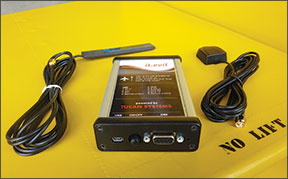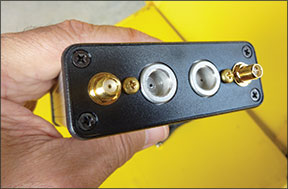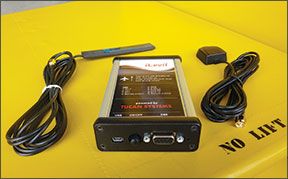Amidst the swarm of ADS-B portables we saw last spring was Levil’s iLevil, which combines ADS-B with a MEMS AHRS for display on cockpit tablets. (See the June 2013 Aviation Consumer for a report.) Levil has followed up with the $1395 AW model, which adds pitot/static sensing to the basic AHRS. So instead of GPS groundspeed and pressure altitude, the device—running through a tablet app—will display indicated airspeed and pressure altitude.

The basic box is larger than the iLevil, measuring 3 by 5 by 1 inch, compared to 2.5 by 4 by 1 inch for the previous model. Two ports on the back accommodate pitot pressure and static input while two antenna jacks for ADS-B and GPS signal that this product is intended for remote mount. The antenna leads have plenty of length, so you could lodge it in the airplane anywhere, as long as it’s away from ferrous metal and with its long axis aligned in the direction of flight.
On the front edge of the unit is a push on/off switch and a standard DB9 female connector. You can power it with ship’s voltage—8 to 32 volts—or rely on internal power from an onboard battery.
This product pushes the limits of what a portable can do, given that the DB9 connector outputs serial data that can feed non-certified panel mount equipment, and it will accept data input from the Zaon XRA portable traffic unit. Like the iLevil, the AW communicates wirelessly.
Now about that plumbing. To read out indicated airspeed, you’ll need at least pitot reference pressure. Unless you’re a stickler for precision, the static port can be referenced inside the aircraft, saving an additional hose. Although the AW is intended for experimental and LSA use, an owner wanting to add it to a certified airplane might make do. You’ll need your shop to finagle a temporary tap into the pitot system that will still pass FAR 91.411 checks if you intend IFR.

Given the plumbing and remote antennas, the mounting perch should be somewhere other than the glareshield. A hatrack mount might do, with the antennas placed in view of a window. For our test in a J-3 Cub, we fabricated a temporary pitot system and used static pressure inside the aircraft.
Flying It
Three apps support the AW, including Levil’s own AHRS utility, Xavion and WingX Pro 7. The latter has a pull-up menu that enables pitot input and this is the only setting required for airspeed sensing.
In flight, the AW data behaves like the airspeed indicator on any ADAHRS-driven EFIS. Its response is linear and free of the spikiness evident on tablet EFIS displays that rely on GPS groundspeed for an airspeed indication. Indicated speed doesn’t change according to wind direction, which GPS groundspeed does, of course. Performance wise, the AW isn’t perfect. We had several data dropouts that red-x’d the display for a few seconds during a trial flight. These cleared on their own without manual intervention. Levil couldn’t say why they occurred.
So what’s the AW good for? We’ll stick by the same conclusion we offered in our June report. These gadgets aren’t reliable enough for real IFR backup, but are suitable for sophisticated secondary position awareness, ADS-B weather, minimal traffic and—might as we’ll be honest—the novelty factor. If that’s worth $1395 and a few bucks in tubing to you, there are worse things to spend money on. For more, see www.levil.com.





